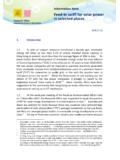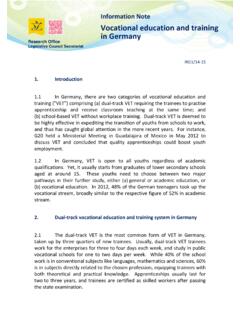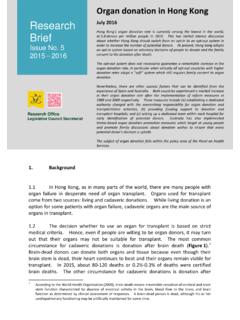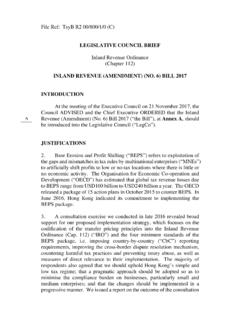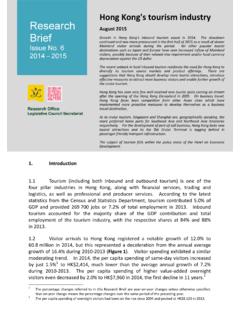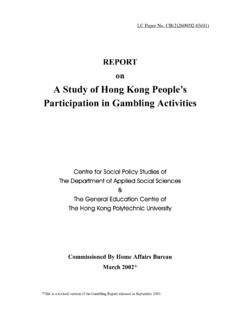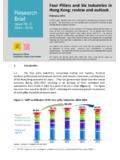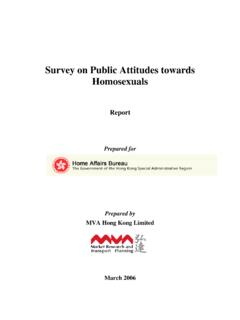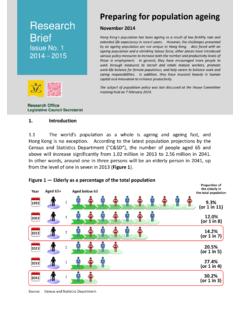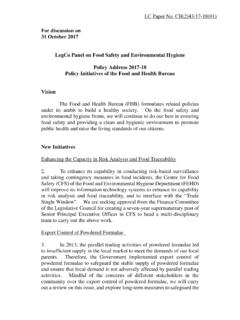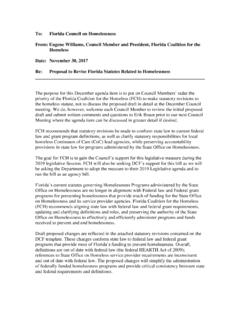Transcription of LEGISLATIVE COUNCIL PANEL ON TRANSPORT …
1 LEGISLATIVE COUNCIL PANEL ON TRANSPORT . Speed Limit in Hong Kong PURPOSE. This paper presents - (a) the structure of speed limit categorisation and the criteria of setting speed limits on roads in Hong Kong;. (b) the review of speed limits in Hong Kong; and (c) the relationship between traffic accidents and speed limit. BACKGROUND. 2. On 17 December 1999, the Administration presented to the LegCo PANEL on TRANSPORT a proposal to increase the fixed penalty and Driving-Offence Points for serious speeding offences as measures to combat speeding. At the meeting, Members expressed reservations over the appropriateness of the structure of our existing speed limit categorisation and asked the Administration to provide further information on the subject. SPEED LIMIT STRUCTURE IN HONG KONG.
2 Speed limit categorisation 3. In Hong Kong, speed limits are imposed primarily to promote road safety. At present, our speed limit structure comprises the following 3 main categories:- Low band - 50 km/h for urban or new town built-up areas Middle band - 70/80 km/h for areas outside urban or new town built-up areas High band - 100 km/h for high standard expressways, North Lantau Highway being the one exception (110/km/h). - 2 - 4. In general, 50 km/h is the standard speed limit on roads in the built-up areas, whether they are in Hong Kong, Kowloon or the New Territories. For areas outside the built up areas in Hong Kong and Kowloon, the speed limit is 70 km/h. For areas outside the built-up areas in the New Territories, the speed limit is 70/80 km/h. For high standard expressways, the speed limit is 100 km/h1.
3 5. Under the existing legislation, the maximum speed limit for medium/heavy goods vehicles and buses shall remain at 70 km/h when they are travelling on roads with speed limits over 70 km/h. Study on Hong Kong's Speed Limit Structure 6. During the review of speed limits in 1999, the Administration commissioned the TRANSPORT Research Laboratory (TRL) in the , an independent leading TRANSPORT research establishment in the world, to carry out a Study on the Speed Limits in Hong Kong. The purpose of the consultancy study is to research into the latest overseas practices of major countries for reviewing Hong Kong's current speed limit standards/practices and to ascertain whether the speed limit structure as stated in paragraph 3 above is best fitted for Hong Kong. 7.
4 It is an international practice that different speed limits are set for different types of roads. Most European countries (as well as Japan, Canada and Australia) adopt a four-tier or even five-tier speed limit structure (usually stepwise increase of 10-20 km/h). A comparison of the speed limits adopted for different types of roads in Europe is at Annex A. 8. For built-up or urban areas, it is noted that 50 km/h is commonly adopted by many countries as the general speed limit. On fast urban roads, the speed limits are mainly set in the region of 60 to 80 km/h. These roads may, or may not, be dual carriageways but will have controlled junctions, pedestrian separation and limited frontage access. These generally correspond with Hong Kong's rural and urban trunk roads and primary distributor roads whose standard speed limits and design speeds are 70 km/h.
5 9. On motor roads, the speed limits commonly adopted are in the range of 90 to 100 km/h for light vehicles. These roads generally correspond to Hong Kong's urban expressways and older rural dual-carriageways, such as the Tuen Mun Road and other highways built to difficult geometry. In Hong Kong, the speed limits for these roads are 70 or 80 km/h. Whilst these limits may appear low as compared with international standards, the study showed that Note 1 : There is an exception of adopting a speed limit of 110 km/h on North Lantau Highway which is a longer distance road, engineered to higher design speeds, and with minimal interference from slip roads, etc. - 3 - the traffic mix and difficult geometry of many Hong Kong roads would make a lower speed limit more appropriate.
6 10. On motorways, which are usually dual carriageway roads with limited access and with grade-separated junctions, the international practice generally sets speed limits in the range of 100-130 km/h. International practice is also that the design speeds of such motorways will at least equal the speed limit. There are views that a speed limit of 100/110 km/h for motorways in Hong Kong may be conservative. However, the design speeds for Hong Kong's new motorways are usually set at 100 km/h. The adoption of a higher speed limit requires a more stringent design standard on requirements such as the minimum radius of horizontal and vertical curves, sight distances, signing, etc. Raising the design speed of existing and new roads to these standards would have significant implications on cost and land take.
7 Also, the limited lengths of such highway in Hong Kong would make any savings in journey time minimal. 11. The study concludes that the speed limit structure adopted in Hong Kong generally accords with international practice, and TRL recommends that our present speed limit structure is suitable and that no changes should be made. Criteria in determining the speed limit of roads in Hong Kong 12. Currently, the standard speed limits applied to new roads in Hong Kong are set out in paragraph 3 above and in detail in the TRANSPORT Department's TRANSPORT Planning & Design Manual Volume 6. The design speed for highways is generally determined according to the road type, and the speed limit for these highways is usually set at, or slightly below, the design speed for road safety reasons.
8 REVIEW OF SPEED LIMITS. 13. Review of speed limit is an on-going exercise. Relaxation would only be recommended if it would not impair road safety. When carrying out a detailed examination of the concerned road section, the Administration would take into account the following factors - (a) the number of changes in speed limit on a stretch of roads should be minimised. For local hazards, consideration should be given to providing appropriate warning rather than lowering the speed limit. The length of road section under consideration should not be less than 1 km;. (b) the design speed and environment of the road section;. - 4 - (c) the accident history of the road section;. (d) the prevailing speed adopted by the majority of drivers of light vehicles during off-peak periods, 85th percentile vehicle speed.
9 And (e) the road surface characteristics if the speed limit of a road is to be relaxed to 80 km/h or above. 14. Since March last year, a review of speed limits on more than 40. major road sections has been completed and the speed limits on 19 of them (18. already implemented and 1 being circulated for comments prior to implementation) have been relaxed. The speed limits for the remaining road sections are maintained. Examples of application of review procedures 15. As explained in paragraph 12 above, the design speed of a highway would normally govern its speed limit. For example, the design speed for Island Eastern Corridor (IEC) is 70 km/h which sets constraints on the geometric design of IEC in terms of curvature (radii), super-elevation, sight-line requirement, spacing of junctions and weaving lengths, etc.
10 It is also noted that the junctions along the road are relatively close with high weaving/merging activities. It is considered that any increase in speed limit higher than the design speed of this road as a whole is undesirable. Increase in speed limit over different stretches of the road is also not recommended for reasons of consistency. 16. In reviewing the speed limit of our roads, the Administration has adopted a general principle of avoiding frequent and abrupt changes. We would, as far as possible, adopt a single speed limit for the whole stretch of a road where appropriate. For example, we have raised the speed limit of a short section of West Kowloon Corridor at Cheung Sha Wan (about km long) and a short section of Castle Peak Road between Tuen Mun and Yuen Long from 50.
